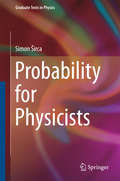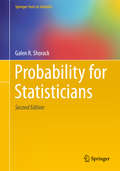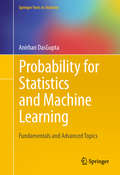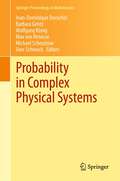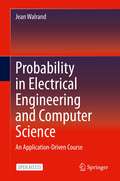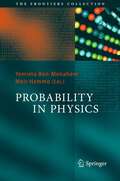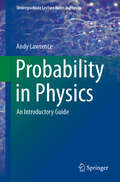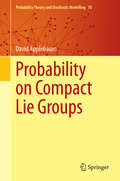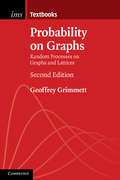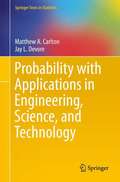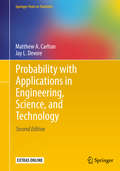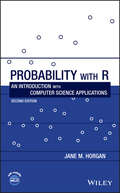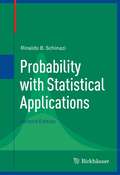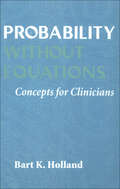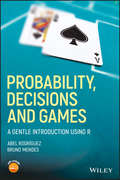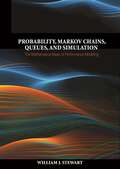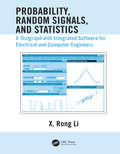- Table View
- List View
Probability for Physicists
by Simon SircaThis book is designed as a practical and intuitive introduction to probability, statistics and random quantities for physicists. The book aims at getting to the main points by a clear, hands-on exposition supported by well-illustrated and worked-out examples. A strong focus on applications in physics and other natural sciences is maintained throughout. In addition to basic concepts of random variables, distributions, expected values and statistics, the book discusses the notions of entropy, Markov processes, and fundamentals of random number generation and Monte-Carlo methods.
Probability for Statisticians
by Galen R. ShorackThe choice of examples used in this text clearly illustrate its use for a one-year graduate course. The material to be presented in the classroom constitutes a little more than half the text, while the rest of the text provides background, offers different routes that could be pursued in the classroom, as well as additional material that is appropriate for self-study. Of particular interest is a presentation of the major central limit theorems via Steins method either prior to or alternative to a characteristic function presentation. Additionally, there is considerable emphasis placed on the quantile function as well as the distribution function, with both the bootstrap and trimming presented. The section on martingales covers censored data martingales.
Probability for Statistics and Machine Learning
by Anirban DasguptaThis book provides a versatile and lucid treatment of classic as well as modern probability theory, while integrating them with core topics in statistical theory and also some key tools in machine learning. It is written in an extremely accessible style, with elaborate motivating discussions and numerous worked out examples and exercises. The book has 20 chapters on a wide range of topics, 423 worked out examples, and 808 exercises. It is unique in its unification of probability and statistics, its coverage and its superb exercise sets, detailed bibliography, and in its substantive treatment of many topics of current importance. This book can be used as a text for a year long graduate course in statistics, computer science, or mathematics, for self-study, and as an invaluable research reference on probabiliity and its applications. Particularly worth mentioning are the treatments of distribution theory, asymptotics, simulation and Markov Chain Monte Carlo, Markov chains and martingales, Gaussian processes, VC theory, probability metrics, large deviations, bootstrap, the EM algorithm, confidence intervals, maximum likelihood and Bayes estimates, exponential families, kernels, and Hilbert spaces, and a self contained complete review of univariate probability.
Probability in Complex Physical Systems
by Wolfgang König Barbara Gentz Jean-Dominique Deuschel Max Von Renesse Michael Scheutzow Uwe SchmockProbabilistic approaches have played a prominent role in the study of complex physical systems for more than thirty years. This volume collects twenty articles on various topics in this field, including self-interacting random walks and polymer models in random and non-random environments, branching processes, Parisi formulas and metastability in spin glasses, and hydrodynamic limits for gradient Gibbs models. The majority of these articles contain original results at the forefront of contemporary research; some of them include review aspects and summarize the state-of-the-art on topical issues - one focal point is the parabolic Anderson model, which is considered with various novel aspects including moving catalysts, acceleration and deceleration and fron propagation, for both time-dependent and time-independent potentials. The authors are among the world's leading experts. This Festschrift honours two eminent researchers, Erwin Bolthausen and Jürgen Gärtner, whose scientific work has profoundly influenced the field and all of the present contributions.
Probability in Electrical Engineering and Computer Science: An Application-Driven Course
by Jean WalrandThis revised textbook motivates and illustrates the techniques of applied probability by applications in electrical engineering and computer science (EECS). The author presents information processing and communication systems that use algorithms based on probabilistic models and techniques, including web searches, digital links, speech recognition, GPS, route planning, recommendation systems, classification, and estimation. He then explains how these applications work and, along the way, provides the readers with the understanding of the key concepts and methods of applied probability. Python labs enable the readers to experiment and consolidate their understanding. The book includes homework, solutions, and Jupyter notebooks. This edition includes new topics such as Boosting, Multi-armed bandits, statistical tests, social networks, queuing networks, and neural networks. For ancillaries related to this book, including examples of Python demos and also Python labs used in Berkeley, please email Mary James at mary.james@springer.com. This is an open access book.
Probability in Physics
by Meir Hemmo Yemima Ben-MenahemWhat is the role and meaning of probability in physical theory, in particular in two of the most successful theories of our age, quantum physics and statistical mechanics? Laws once conceived as universal and deterministic, such as Newton's laws of motion, or the second law of thermodynamics, are replaced in these theories by inherently probabilistic laws. This collection of essays by some of the world's foremost experts presents an in-depth analysis of the meaning of probability in contemporary physics. Among the questions addressed are: How are probabilities defined? Are they objective or subjective? What is their explanatory value? What are the differences between quantum and classical probabilities? The result is an informative and thought-provoking book for the scientifically inquisitive.
Probability in Physics: An Introductory Guide (Undergraduate Lecture Notes in Physics)
by Andy LawrenceThis textbook presents an introduction to the use of probability in physics, treating introductory ideas of both statistical physics and of statistical inference, as well the importance of probability in information theory, quantum mechanics, and stochastic processes, in a unified manner. The book also presents a harmonised view of frequentist and Bayesian approaches to inference, emphasising their complementary value. The aim is to steer a middle course between the "cookbook" style and an overly dry mathematical statistics style. The treatment is driven by real physics examples throughout, but developed with a level of mathematical clarity and rigour appropriate to mid-career physics undergraduates. Exercises and solutions are included.
Probability on Compact Lie Groups
by David ApplebaumProbability theory on compact Lie groups deals with the interaction between "chance" and "symmetry," a beautiful area of mathematics of great interest in its own sake but which is now also finding increasing applications in statistics and engineering (particularly with respect to signal processing). The author gives a comprehensive introduction to some of the principle areas of study, with an emphasis on applicability. The most important topics presented are: the study of measures via the non-commutative Fourier transform, existence and regularity of densities, properties of random walks and convolution semigroups of measures and the statistical problem of deconvolution. The emphasis on compact (rather than general) Lie groups helps readers to get acquainted with what is widely seen as a difficult field but which is also justified by the wealth of interesting results at this level and the importance of these groups for applications. The book is primarily aimed at researchers working in probability, stochastic analysis and harmonic analysis on groups. It will also be of interest to mathematicians working in Lie theory and physicists, statisticians and engineers who are working on related applications. A background in first year graduate level measure theoretic probability and functional analysis is essential; a background in Lie groups and representation theory is certainly helpful but the first two chapters also offer orientation in these subjects.
Probability on Graphs
by Geoffrey GrimmettThis introduction to some of the principal models in the theory of disordered systems leads the reader through the basics, to the very edge of contemporary research, with the minimum of technical fuss. Topics covered include random walk, percolation, self-avoiding walk, interacting particle systems, uniform spanning tree, random graphs, as well as the Ising, Potts, and random-cluster models for ferromagnetism, and the Lorentz model for motion in a random medium. Schramm-Löwner evolutions (SLE) arise in various contexts. The choice of topics is strongly motivated by modern applications and focuses on areas that merit further research. Special features include a simple account of Smirnov's proof of Cardy's formula for critical percolation, and a fairly full account of the theory of influence and sharp-thresholds. Accessible to a wide audience of mathematicians and physicists, this book can be used as a graduate course text. Each chapter ends with a range of exercises.
Probability on Graphs: Random Processes on Graphs and Lattices (Institute of Mathematical Statistics Textbooks #8)
by Geoffrey GrimmettThis introduction to some of the principal models in the theory of disordered systems leads the reader through the basics, to the very edge of contemporary research, with the minimum of technical fuss. Topics covered include random walk, percolation, self-avoiding walk, interacting particle systems, uniform spanning tree, random graphs, as well as the Ising, Potts, and random-cluster models for ferromagnetism, and the Lorentz model for motion in a random medium. Schramm-Lwner evolutions (SLE) arise in various contexts. The choice of topics is strongly motivated by modern applications and focuses on areas that merit further research. Special features include a simple account of Smirnov's proof of Cardy's formula for critical percolation, and a fairly full account of the theory of influence and sharp-thresholds. Accessible to a wide audience of mathematicians and physicists, this book can be used as a graduate course text. Each chapter ends with a range of exercises.
Probability on Real Lie Algebras
by Uwe Franz Nicolas PrivaultThis monograph is a progressive introduction to non-commutativity in probability theory, summarizing and synthesizing recent results about classical and quantum stochastic processes on Lie algebras. In the early chapters, focus is placed on concrete examples of the links between algebraic relations and the moments of probability distributions. The subsequent chapters are more advanced and deal with Wigner densities for non-commutative couples of random variables, non-commutative stochastic processes with independent increments (quantum Lévy processes), and the quantum Malliavin calculus. This book will appeal to advanced undergraduate and graduate students interested in the relations between algebra, probability, and quantum theory. It also addresses a more advanced audience by covering other topics related to non-commutativity in stochastic calculus, Lévy processes, and the Malliavin calculus.
Probability with Applications in Engineering, Science, and Technology
by Jay L. Devore Matthew A. CarltonThis book provides a contemporary and lively postcalculus introduction to the subject of probability. The exposition reflects a desirable balance between fundamental theory and many applications involving a broad range of real problem scenarios. It is intended to appeal to a wide audience, including mathematics and statistics majors, prospective engineers and scientists, and those business and social science majors interested in the quantitative aspects of their disciplines. A one-term course would cover material in the core chapters (1-4), hopefully supplemented by selections from one or more of the remaining chapters on statistical inference (Ch. 5), Markov chains (Ch. 6), stochastic processes (Ch. 7), and signal processing (Ch. 8). The last chapter is specifically designed for electrical and computer engineers, making the book suitable for a one-term class on random signals and noise. Alternatively, there is certainly enough material for those lucky enough to be teaching or taking a year-long course. Most of the core will be accessible to those who have taken a year of univariate differential and integral calculus; matrix algebra, multivariate calculus, and engineering mathematics are needed for the later, more advanced chapters. One unique feature of this book is the inclusion of sections that illustrate the importance of software for carrying out simulations when answers to questions cannot be obtained analytically; R and Matlab code are provided so that students can create their own simulations. Another feature that sets this book apart is the Introduction, which addresses the question "Why study probability?" by surveying selected examples from recent journal articles and discussing some classic problems whose solutions run counter to intuition. The book contains about 1100 exercises, ranging from straightforward to reasonably challenging; roughly 700 of these appear in the first four chapters. The book's preface provides more information about our purpose, content, mathematical level, and suggestions for what can be covered in courses of varying duration.
Probability with Applications in Engineering, Science, and Technology
by Jay L. Devore Matthew A. CarltonThis book provides a contemporary and lively postcalculus introduction to the subject of probability. The exposition reflects a desirable balance between fundamental theory and many applications involving a broad range of real problem scenarios. It is intended to appeal to a wide audience, including mathematics and statistics majors, prospective engineers and scientists, and those business and social science majors interested in the quantitative aspects of their disciplines. A one-term course would cover material in the core chapters (1-4), hopefully supplemented by selections from one or more of the remaining chapters on statistical inference (Ch. 5), Markov chains (Ch. 6), stochastic processes (Ch. 7), and signal processing (Ch. 8). The last chapter is specifically designed for electrical and computer engineers, making the book suitable for a one-term class on random signals and noise. Alternatively, there is certainly enough material for those lucky enough to be teaching or taking a year-long course. Most of the core will be accessible to those who have taken a year of univariate differential and integral calculus; matrix algebra, multivariate calculus, and engineering mathematics are needed for the later, more advanced chapters. One unique feature of this book is the inclusion of sections that illustrate the importance of software for carrying out simulations when answers to questions cannot be obtained analytically; R and Matlab code are provided so that students can create their own simulations. Another feature that sets this book apart is the Introduction, which addresses the question "Why study probability?" by surveying selected examples from recent journal articles and discussing some classic problems whose solutions run counter to intuition. The book contains about 1100 exercises, ranging from straightforward to reasonably challenging; roughly 700 of these appear in the first four chapters. The book's preface provides more information about our purpose, content, mathematical level, and suggestions for what can be covered in courses of varying duration.
Probability with Martingales
by David WilliamsThis is a masterly introduction to the modern and rigorous theory of probability. The author adopts the martingale theory as his main theme and moves at a lively pace through the subject's rigorous foundations. Measure theory is introduced and then immediately exploited by being applied to real probability theory. Classical results, such as Kolmogorov's Strong Law of Large Numbers and Three-Series Theorem are proved by martingale techniques. A proof of the Central Limit Theorem is also given. The author's style is entertaining and inimitable with pedagogy to the fore. Exercises play a vital role; there is a full quota of interesting and challenging problems, some with hints.
Probability with R: An Introduction with Computer Science Applications
by Jane M. HorganProvides a comprehensive introduction to probability with an emphasis on computing-related applications This self-contained new and extended edition outlines a first course in probability applied to computer-related disciplines. As in the first edition, experimentation and simulation are favoured over mathematical proofs. The freely down-loadable statistical programming language R is used throughout the text, not only as a tool for calculation and data analysis, but also to illustrate concepts of probability and to simulate distributions. The examples in Probability with R: An Introduction with Computer Science Applications, Second Edition cover a wide range of computer science applications, including: testing program performance; measuring response time and CPU time; estimating the reliability of components and systems; evaluating algorithms and queuing systems. Chapters cover: The R language; summarizing statistical data; graphical displays; the fundamentals of probability; reliability; discrete and continuous distributions; and more. This second edition includes: improved R code throughout the text, as well as new procedures, packages and interfaces; updated and additional examples, exercises and projects covering recent developments of computing; an introduction to bivariate discrete distributions together with the R functions used to handle large matrices of conditional probabilities, which are often needed in machine translation; an introduction to linear regression with particular emphasis on its application to machine learning using testing and training data; a new section on spam filtering using Bayes theorem to develop the filters; an extended range of Poisson applications such as network failures, website hits, virus attacks and accessing the cloud; use of new allocation functions in R to deal with hash table collision, server overload and the general allocation problem. The book is supplemented with a Wiley Book Companion Site featuring data and solutions to exercises within the book. Primarily addressed to students of computer science and related areas, Probability with R: An Introduction with Computer Science Applications, Second Edition is also an excellent text for students of engineering and the general sciences. Computing professionals who need to understand the relevance of probability in their areas of practice will find it useful.
Probability with Statistical Applications
by Rinaldo B. SchinaziThis second edition textbook offers a practical introduction to probability for undergraduates at all levels with different backgrounds and views towards applications. Calculus is a prerequisite for understanding the basic concepts, however the book is written with a sensitivity to students' common difficulties with calculus that does not obscure the thorough treatment of the probability content. The first six chapters of this text neatly and concisely cover the material traditionally required by most undergraduate programs for a first course in probability. The comprehensive text includes a multitude of new examples and exercises, and careful revisions throughout. Particular attention is given to the expansion of the last three chapters of the book with the addition of one entirely new chapter (9) on 'Finding and Comparing Estimators.' The classroom-tested material presented in this second edition forms the basis for a second course introducing mathematical statistics.
Probability without Equations: Concepts for Clinicians
by Bart K. HollandAn award-winning teacher gives a non-technical explanation of the probability and statistics needed by physicians to interpret laboratory results.Although few physicians, nurses, dentists, and other health professionals perform laboratory tests themselves, they all need to be able to interpret the results as well as understand findings reported in the medical literature. A general understanding of probability and statistics is essential for those needing to make daily decisions about the significance of research data, drug interaction precautions, or a patient's positive laboratory test for a rare disease.Written with these needs in mind, Probability without Equations offers a thorough explanation of the subject without overwhelming the reader with equations and footnotes. Award-winning teacher Bart Holland presents a nontechnical treatment of intuitive concepts and presents numerous examples from medical research and practice. In plain language, this book explains the topics that clinicians need to understand:• Analysis of variance• "P-values" and the "t-test"• Hazard models• Regression and correlations• Alpha and beta errors"The Nobel prize-winning physicist Ernest Rutherford was fond of saying that if you need statistics to analyze the results of an experiment, you don't have a very good experiment. In a way he was right. However, a recurrent problem in medicine is that in a certain sense you commonly don't have a good experiment—but not because medical research scientists are generally incompetent! The nature of the data they work with is simply not as predictable as the data in some other fields, so the predictive nature of findings in medical science is generally rather imperfect."—from the introduction
Probability, Decisions and Games: A Gentle Introduction using R
by Abel Rodríguez Bruno MendesINTRODUCES THE FUNDAMENTALS OF PROBABILITY, STATISTICS, DECISION THEORY, AND GAME THEORY, AND FEATURES INTERESTING EXAMPLES OF GAMES OF CHANCE AND STRATEGY TO MOTIVATE AND ILLUSTRATE ABSTRACT MATHEMATICAL CONCEPTS Covering both random and strategic games, Probability, Decisions and Games features a variety of gaming and gambling examples to build a better understanding of basic concepts of probability, statistics, decision theory, and game theory. The authors present fundamental concepts such as random variables, rational choice theory, mathematical expectation and variance, fair games, combinatorial calculus, conditional probability, Bayes Theorem, Bernoulli trials, zero-sum games and Nash equilibria, as well as their application in games such as Roulette, Craps, Lotto, Blackjack, Poker, Rock-Paper-Scissors, the Game of Chicken and Tic-Tac-Toe. Computer simulations, implemented using the popular R computing environment, are used to provide intuition on key concepts and verify complex calculations. The book starts by introducing simple concepts that are carefully motivated by the same historical examples that drove their original development of the field of probability, and then applies those concepts to popular contemporary games. The first two chapters of Probability, Decisions and Games: A Gentle Introduction using R feature an introductory discussion of probability and rational choice theory in finite and discrete spaces that builds upon the simple games discussed in the famous correspondence between Blaise Pascal and Pierre de Fermat. Subsequent chapters utilize popular casino games such as Roulette and Blackjack to expand on these concepts illustrate modern applications of these methodologies. Finally, the book concludes with discussions on game theory using a number of strategic games. This book: · Features introductory coverage of probability, statistics, decision theory and game theory, and has been class-tested at University of California, Santa Cruz for the past six years · Illustrates basic concepts in probability through interesting and fun examples using a number of popular casino games: roulette, lotto, craps, blackjack, and poker · Introduces key ideas in game theory using classic games such as Rock-Paper-Scissors, Chess, and Tic-Tac-Toe. · Features computer simulations using R throughout in order to illustrate complex concepts and help readers verify complex calculations · Contains exercises and approaches games and gambling at a level that is accessible for readers with minimal experience · Adopts a unique approach by motivating complex concepts using first simple games and then moving on to more complex, well-known games that illustrate how these concepts work together Probability, Decisions and Games: A Gentle Introduction using R is a unique and helpful textbook for undergraduate courses on statistical reasoning, introduction to probability, statistical literacy, and quantitative reasoning for students from a variety of disciplines. ABEL RODRÍGUEZ, PhD, is Professor in the Department of Applied Mathematics and Statistics at the University of California, Santa Cruz (UCSC), CA, USA. The author of 40 journal articles, his research interests include Bayesian nonparametric methods, machine learning, spatial temporal models, network models, and extreme value theory. BRUNO MENDES, PhD, is Lecturer in the Department of Applied Mathematics and Statistics at the University of California, Santa Cruz, CA, USA. BRUNO MENDES, PhD, is Lecturer in the Department of Applied Mathematics and Statistics at the University of Cal
Probability, Markov Chains, Queues, and Simulation: The Mathematical Basis of Performance Modeling
by William J. StewartProbability, Markov Chains, Queues, and Simulation provides a modern and authoritative treatment of the mathematical processes that underlie performance modeling. The detailed explanations of mathematical derivations and numerous illustrative examples make this textbook readily accessible to graduate and advanced undergraduate students taking courses in which stochastic processes play a fundamental role. The textbook is relevant to a wide variety of fields, including computer science, engineering, operations research, statistics, and mathematics.The textbook looks at the fundamentals of probability theory, from the basic concepts of set-based probability, through probability distributions, to bounds, limit theorems, and the laws of large numbers. Discrete and continuous-time Markov chains are analyzed from a theoretical and computational point of view. Topics include the Chapman-Kolmogorov equations; irreducibility; the potential, fundamental, and reachability matrices; random walk problems; reversibility; renewal processes; and the numerical computation of stationary and transient distributions. The M/M/1 queue and its extensions to more general birth-death processes are analyzed in detail, as are queues with phase-type arrival and service processes. The M/G/1 and G/M/1 queues are solved using embedded Markov chains; the busy period, residual service time, and priority scheduling are treated. Open and closed queueing networks are analyzed. The final part of the book addresses the mathematical basis of simulation.Each chapter of the textbook concludes with an extensive set of exercises. An instructor's solution manual, in which all exercises are completely worked out, is also available (to professors only).Numerous examples illuminate the mathematical theoriesCarefully detailed explanations of mathematical derivations guarantee a valuable pedagogical approachEach chapter concludes with an extensive set of exercises
Probability, Random Processes, and Statistical Analysis
by Hisashi Kobayashi Brian L. Mark William TurinTogether with the fundamentals of probability, random processes, and statistical analysis, this insightful book also presents a broad range of advanced topics and applications. There is extensive coverage of Bayesian vs. frequentist statistics, time series and spectral representation, inequalities, bound and approximation, maximum-likelihood estimation and the expectation-maximization (EM) algorithm, geometric Brownian motion and Itô process. Applications such as hidden Markov models (HMM), the Viterbi, BCJR, and Baum-Welch algorithms, algorithms for machine learning, Wiener and Kalman filters, queueing and loss networks, and are treated in detail. The book will be useful to students and researchers in such areas as communications, signal processing, networks, machine learning, bioinformatics, econometrics and mathematical finance. With a solutions manual, lecture slides, supplementary materials, and MATLAB programs all available online, it is ideal for classroom teaching as well as a valuable reference for professionals.
Probability, Random Signals, and Statistics
by X. Rong LiWith this innovative text, the study-and teaching- of probability and random signals becomes simpler, more streamlined, and more effective. Its unique "textgraph" format makes it both student-friendly and instructor-friendly. Pages with a larger typeface form a concise text for basic topics and make ideal transparencies; pages with smaller type provide more detailed explanations and more advanced material.
Probability, Random Variables, Statistics, and Random Processes: Fundamentals & Applications
by Ali GramiProbability, Random Variables, Statistics, and Random Processes: Fundamentals & Applications is a comprehensive undergraduate-level textbook. With its excellent topical coverage, the focus of this book is on the basic principles and practical applications of the fundamental concepts that are extensively used in various Engineering disciplines as well as in a variety of programs in Life and Social Sciences. The text provides students with the requisite building blocks of knowledge they require to understand and progress in their areas of interest. With a simple, clear-cut style of writing, the intuitive explanations, insightful examples, and practical applications are the hallmarks of this book. The text consists of twelve chapters divided into four parts. Part-I, Probability (Chapters 1 – 3), lays a solid groundwork for probability theory, and introduces applications in counting, gambling, reliability, and security. Part-II, Random Variables (Chapters 4 – 7), discusses in detail multiple random variables, along with a multitude of frequently-encountered probability distributions. Part-III, Statistics (Chapters 8 – 10), highlights estimation and hypothesis testing. Part-IV, Random Processes (Chapters 11 – 12), delves into the characterization and processing of random processes. Other notable features include: Most of the text assumes no knowledge of subject matter past first year calculus and linear algebra With its independent chapter structure and rich choice of topics, a variety of syllabi for different courses at the junior, senior, and graduate levels can be supported A supplemental website includes solutions to about 250 practice problems, lecture slides, and figures and tables from the text Given its engaging tone, grounded approach, methodically-paced flow, thorough coverage, and flexible structure, Probability, Random Variables, Statistics, and Random Processes: Fundamentals & Applications clearly serves as a must textbook for courses not only in Electrical Engineering, but also in Computer Engineering, Software Engineering, and Computer Science.
Probability, Random Variables, and Data Analytics with Engineering Applications
by P. Mohana ShankarThis book bridges the gap between theory and applications that currently exist in undergraduate engineering probability textbooks. It offers examples and exercises using data (sets) in addition to traditional analytical and conceptual ones. Conceptual topics such as one and two random variables, transformations, etc. are presented with a focus on applications. Data analytics related portions of the book offer detailed coverage of receiver operating characteristics curves, parametric and nonparametric hypothesis testing, bootstrapping, performance analysis of machine vision and clinical diagnostic systems, and so on. With Excel spreadsheets of data provided, the book offers a balanced mix of traditional topics and data analytics expanding the scope, diversity, and applications of engineering probability. This makes the contents of the book relevant to current and future applications students are likely to encounter in their endeavors after completion of their studies. A full suite of classroom material is included. A solutions manual is available for instructors. Bridges the gap between conceptual topics and data analytics through appropriate examples and exercises; Features 100's of exercises comprising of traditional analytical ones and others based on data sets relevant to machine vision, machine learning and medical diagnostics;Intersperses analytical approaches with computational ones, providing two-level verifications of a majority of examples and exercises.
Probability, Statistics and Life Cycle Assessment: Guidance for Dealing with Uncertainty and Sensitivity
by Reinout HeijungsThis textbook discusses the use of uncertainty analysis and sensitivity analysis in environmental life cycle assessment (LCA). This is a topic which has received a lot of attention by journals, including the leading (Springer) International Journal of Life Cycle Assessment. Despite its importance, no coherent textbook exists that summarizes the progress that has been made in the last 20 years. This book attempts to fill that gap. Its audience is practitioners (professional and academic) of LCA, teachers, and Ph.D. students. It gives a very broad overview of the field: probability theory, descriptive statistics, inferential statistics, error analysis, sensitivity analysis, decision theory, etc., all in relation to LCA. Much effort has been taken to give a balanced overview, with a uniform terminology and mathematical notation.
Probability, Statistics, and Data: A Fresh Approach Using R (Chapman & Hall/CRC Texts in Statistical Science)
by Darrin Speegle Bryan ClairThis book is a fresh approach to a calculus based, first course in probability and statistics, using R throughout to give a central role to data and simulation. The book introduces probability with Monte Carlo simulation as an essential tool. Simulation makes challenging probability questions quickly accessible and easily understandable. Mathematical approaches are included, using calculus when appropriate, but are always connected to experimental computations. Using R and simulation gives a nuanced understanding of statistical inference. The impact of departure from assumptions in statistical tests is emphasized, quantified using simulations, and demonstrated with real data. The book compares parametric and non-parametric methods through simulation, allowing for a thorough investigation of testing error and power. The text builds R skills from the outset, allowing modern methods of resampling and cross validation to be introduced along with traditional statistical techniques. Fifty-two data sets are included in the complementary R package fosdata. Most of these data sets are from recently published papers, so that you are working with current, real data, which is often large and messy. Two central chapters use powerful tidyverse tools (dplyr, ggplot2, tidyr, stringr) to wrangle data and produce meaningful visualizations. Preliminary versions of the book have been used for five semesters at Saint Louis University, and the majority of the more than 400 exercises have been classroom tested.
